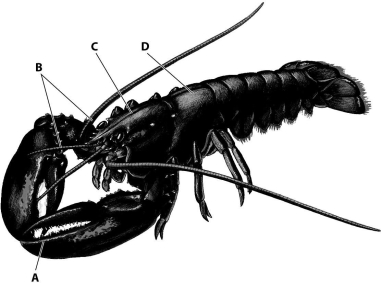A) a fish
B) a lobster
C) a worm
D) a sea anemone
Correct Answer

verified
Correct Answer
verified
Multiple Choice
Which of the following is a unique feature of echinoderms?
A) a water vascular system
B) bilateral symmetry
C) a deuterostome pattern of development
D) radial symmetry
Correct Answer

verified
Correct Answer
verified
Multiple Choice
Flatworms (Platyhelminthes) are _ and typically have .
A) bilaterally symmetrical ...a complete digestive tract with a mouth and anus
B) bilaterally symmetrical ...a gastrovascular cavity with one opening
C) radially symmetrical ...no digestive system
D) all parasites ...no digestive system
Correct Answer

verified
Correct Answer
verified
Multiple Choice
During the Cambrian explosion approximately 535 to 525 million years ago,
A) great forests produced peat layers that were later transformed into coal.
B) animals rapidly diversified in the oceans.
C) all modern species of animals suddenly appeared.
D) a massive volcanic eruption nearly wiped out life on Earth.
Correct Answer

verified
Correct Answer
verified
Multiple Choice
The most numerous,diverse,and widespread animals are the
A) Chordata.
B) Annelida.
C) Mollusca.
D) Arthropoda.
Correct Answer

verified
Correct Answer
verified
Multiple Choice
A bilaterally symmetrical,wormlike animal that has a pseudocoelom,a complete digestive tract,and a cuticle could be a member of which one of the following phyla?
A) Nematoda
B) Cnidaria
C) Chordata
D) Annelida
Correct Answer

verified
Correct Answer
verified
Multiple Choice
Which of the following phyla is most closely related to echinoderms?
A) Annelida
B) Arthropoda
C) Mollusca
D) Chordata
Correct Answer

verified
Correct Answer
verified
Multiple Choice
You find a wormlike,soft- bodied adult animal in a mud flat.It is bilaterally symmetrical,is segmented,has a true coelom,and has a complete digestive tract.Based on these characteristics,what phylum does the animal represent?
A) Cnidaria
B) Annelida
C) Nematoda
D) Platyhelminthes
Correct Answer

verified
Correct Answer
verified
Multiple Choice
The digestive tract of a nematode is most like which of the following?
A) a cup
B) a soda straw
C) a sock
D) a baseball
Correct Answer

verified
B
Correct Answer
verified
Multiple Choice
The is a flagellated cell that sweeps water through a sponge's body.
A) spicule
B) amoebocyte
C) choanocyte
D) spongin
Correct Answer

verified
C
Correct Answer
verified
Multiple Choice
According to recent genetic research,the complexity of an organism
A) is directly correlated with the number of protein- coding genes in its genome.
B) has more to do with how genes are used than with which genes are present.
C) is inversely related to the number of protein- coding genes in its genome.
D) is not related to genes or development,so it must have another source.
Correct Answer

verified
Correct Answer
verified
Multiple Choice
Animals probably evolved from
A) fungi.
B) plants.
C) bacteria.
D) protists.
Correct Answer

verified
Correct Answer
verified
Multiple Choice
A dog's head is at its _ end and its belly is its _ surface.
A) anterior ...dorsal
B) posterior ...ventral
C) posterior ...dorsal
D) anterior ...ventral
Correct Answer

verified
Correct Answer
verified
Multiple Choice
Which part of this figure shows the thorax segment of this lobster? 
A) structure A
B) structure B
C) structure C
D) structure D
Correct Answer

verified
Correct Answer
verified
Multiple Choice
Which of the following statements regarding cnidarians is true?
A) The digestive and circulatory compartment of cnidarians is called the gastrovascular cavity.
B) Cnidarians are herbivores and can be destructive grazers on seaweeds.
C) The more stationary cnidarian body form,which is cylindrical with a ring of tentacles,is the medusa.
D) Cnidarians have three true tissue layers.
Correct Answer

verified
Correct Answer
verified
Multiple Choice
Most of the animals alive today
A) are vertebrates.
B) are invertebrates.
C) are really colonies of protist cells.
D) are choanoflagellates.
Correct Answer

verified
Correct Answer
verified
Multiple Choice
Which mollusc group includes primarily sedentary animals that use mucus- coated gills to trap fine food particles?
A) bivalves
B) chitons
C) cephalopods
D) gastropods
Correct Answer

verified
Correct Answer
verified
Multiple Choice
Which of the following statements about deuterostomes is true?
A) The opening that forms during deuterostome gastrulation becomes the mouth.
B) The opening that forms during deuterostome gastrulation becomes the anus.
C) Deuterostomes lack true tissues.
D) Deuterostomes have only two tissue layers.
Correct Answer

verified
Correct Answer
verified
Multiple Choice
Which of the following structures best represents a hydrostatic skeleton?
A) a water balloon
B) a piece of M & M candy
C) a spoon
D) an empty coffee mug
Correct Answer

verified
Correct Answer
verified
Multiple Choice
Which adaptation is a key characteristic of annelids that greatly increases their flexibility and mobility?
A) segmentation
B) complete digestive tract
C) hydrostatic skeleton
D) three true tissue layers
Correct Answer

verified
A
Correct Answer
verified
Showing 1 - 20 of 55
Related Exams